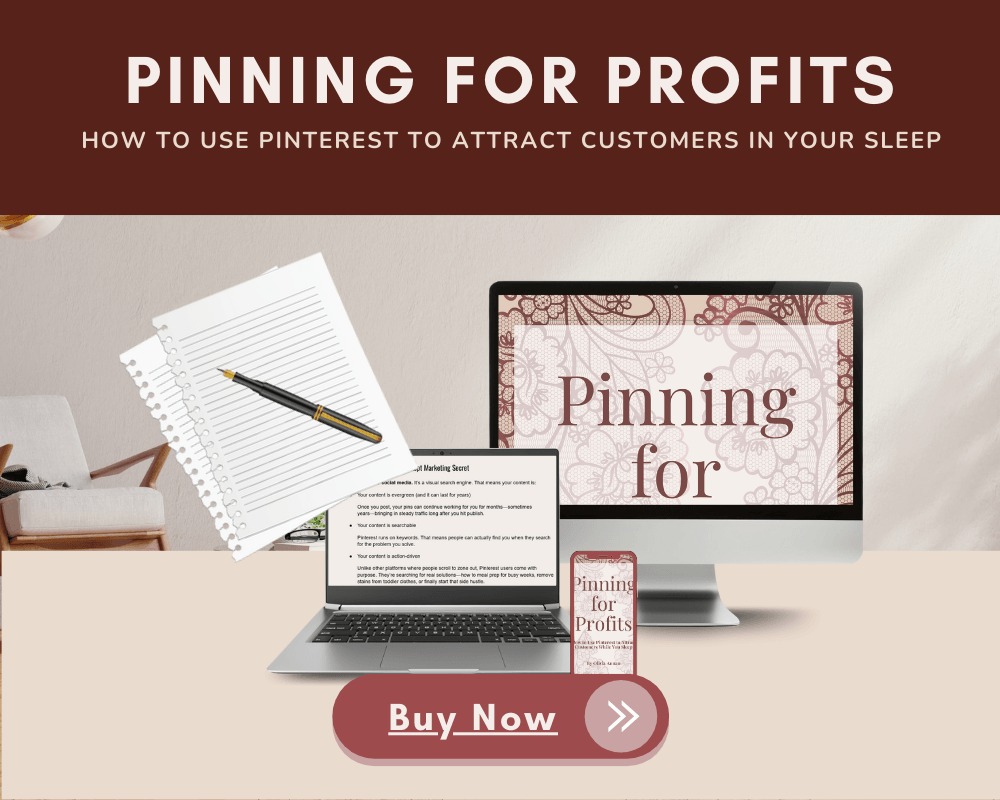Buyers not Browsers: How to use Pinterest to Attract Customers Ready to Purchase
This site may contain links to affiliate websites, and we receive an affiliate commission for any purchase made by you on the affiliate website using such links. Our affiliates include the following: Fiverr. We are a participant in the Amazon Services LLC Associates Program, an affiliate advertising program designed to provide a means for us to earn advertising fees by linking to Amazon.com and Affiliated website.
If you think Instagram and TikTok are going to bring you 100% of your traffic, you're missing a major piece of the puzzle. It’s time to take a serious look at Pinterest.
Pinterest isn’t just another social platform. It’s a visual search engine designed to connect ready-to-buy users with solutions. While people are mindlessly scrolling on Instagram or TikTok, Pinterest users are showing up with purpose. They’re actively searching, planning, and getting closer to making a decision.
And often? That decision includes a purchase.
So here’s the shift: Stop creating content just to catch the eye of casual scrollers. Start creating with the buyer in mind—the action-takers, the planners, the ones who are looking for exactly what you offer.
In this post, I’ll show you how to pivot your Pinterest strategy to attract buyers, not just browsers.
First you Want to Understand the Pinterest Mindset
One of the biggest mistakes I see? Treating Pinterest like a social media platform. Yes, you can follow accounts and send messages but that’s not the heart of it. Pinterest isn’t where people go to kill time. It’s where they go to plan, solve problems, and make decisions. Think of it as a visually curated version of Google.
Whether someone’s planning a baby shower, refreshing their home office, or finally investing in their business, Pinterest users show up with intention. And that’s what sets it apart. The user is already closer to making a purchase.
That makes your job easier. All you need to do is meet them where they are in their journey then guide them straight to your solution.
Use Keywords That Attract Ready-to-Buy Users
You will want to put your content in front of people who are actively searching for what you offer. But here’s the catch: not all keywords are created equal. If you want to attract buyers, you need to use buyer-intent keywords. These are phrases that reflect someone who’s already made the decision to take action.
Instead of using broad terms like “morning routine,” try something more specific, you'll want to try something like “best planners for busy moms” or “morning routine checklist printable.” The more specific you are, the more clear who your audiences is. This will teach the algorithm who your content is for—and then in turn the content will perform better.
Put yourself in your customer’s shoes. What would you type into the search bar if you were ready to buy?
Pinterest is always analyzing (hence being a search engine) place your keywords everywhere—in your pin titles, descriptions, board names, and even your profile bio. Use that space wisely.
Create Pins That Convert
Here’s the truth: pretty pins don’t always perform well. What are the characteristics of a pin that converts? They solve a problem, spark a “Yes, I need that!” reaction, and make it easy for someone to take the next step. You want your image to stop the scroll and guide the click—and that’s exactly why keyword research matters.
Start with a scroll-stopping visuals, but don’t stop there. Pair it with a clear benefit. Use text overlays like “Download the Free Guide,” “Shop Now,” or “Get Instant Access.” Think beyond just making it look nice—focus on what your audience gets from engaging with your pin.
And here’s a tip that changes the game: mockups are your best friend. Show your digital product, lead magnet, or service in action. It builds trust and immediately communicates value.
Now, keep in mind: pins have a much longer lifespan than posts on other platforms. That means growth will take time. But that’s a good thing. You’re planting seeds that keep working for you months from now.
Aim to create 5–7 pins per piece of content, but don’t drop them all at once. Think of your pin creation process like batching, then drip them out over time to stay fresh in the Pinterest ecosystem. Patience here pays off—keep watering what you plant, and your traffic will grow.
Map Out the Customers Journey
People don’t just buy out of nowhere it takes time. They go through a process, and Pinterest gives you the perfect way to support that journey visually and intentionally.
Start by organizing your boards in a way that mirrors how your audience thinks. If you sell templates for business owners, for example, create boards like “Email Marketing Tips,” “Lead Magnet Ideas,” or “Canva Templates for Coaches.” Make it easy for your audience to find exactly what they’re looking for—and position your offers as the natural next step.
Every board should point to a solution—and that solution should lead back to you.
And if you’re not already using Pinterest Trends to plan your content calendar, now’s the time. Pinterest is early when it comes to seasonal search behavior. Whether it’s holiday shopping or back-to-school season, you’ll want to post content well in advance. Typically, you’ll start seeing results about 90 days after posting new pins, which is totally normal.
Instead of thinking, “Ugh, it takes so long to see results,” try flipping that thought: Your content lives longer here than almost any other platform. When you post consistently, you're not just creating more content—you’re building long-term visibility and growing your audience month over month.
It’s just like planting a garden. It takes time for that seed to sprout, but once it does? It often takes off—and it can become wildly abundant.
Be Consistent and Strategic
Pinterest rewards consistency—not volume. You don’t need to pin 50 times a day (and honestly, if you did, your account could get flagged for spam). What you do need is a steady rhythm of content that aligns with what your ideal buyer is searching for.
Batching and scheduling—using Pinterest’s native scheduler or a tool like Tailwind—makes it easy to stay visible without burning yourself out. Keep an eye on what’s working, repurpose your top-performing pins, and experiment with different formats: static graphics, Idea Pins (with links if you have access!), and short videos.
One important tip most people overlook: keep your links up to date. If you’ve stopped offering a product or lead magnet, go back and update those pin URLs. Dead links lead to dead ends—and that breaks the trust you’ve worked so hard to build. Pinterest is all about long-term content, so make sure what you’re sharing today still holds value tomorrow.
Watch What’s Working (And Double Down)
Once your pins are live, it’s time to track your performance—but don’t just obsess over impressions. Instead, focus on the metrics that actually matter: outbound clicks, saves, and engagement. Which pins are getting people to leave Pinterest and land on your site? Which boards are consistently driving traffic to your lead magnets or offers?
Look for patterns. Is there a type of content, design, or keyword that keeps showing up in your top performers? Great now do more of that. Lean into what’s already working to amplify your results.
Pinterest analytics can show you exactly where your buyers are coming from. Use that data to your advantage. Swap out pin designs that aren’t converting, test new CTAs, and fine-tune your keywords. This is where real, sustainable organic growth begins—when you combine strategy with smart, informed adjustments.
Final Thoughts
Pinterest is a powerful tool, but only if you treat it like one. When you stop creating for the scroll and start creating for the sale, everything shifts. Your traffic becomes targeted. Your clicks start converting. And your brand becomes the answer someone was actively searching for.
So ask yourself: Are you pinning for attention—or are you pinning for buyers?
Join the Passive Income Creators Circle
Get weekly tips, tools, and community support to turn your content into cash — even while you sleep.
Hi, I’m Olivia — digital creator, passive income strategist, and mom navigating the beautiful chaos of motherhood.
hello@oliviaannan.com
Quick links
Categories
Newsletter
Subscribe now to get daily updates.
Created with ©systeme.io






